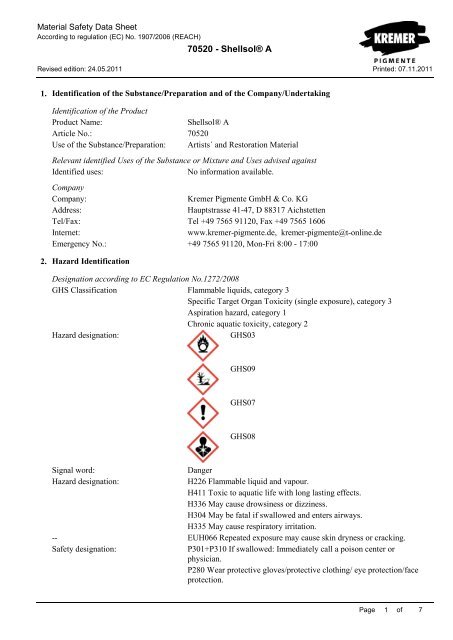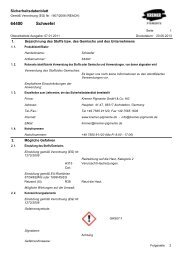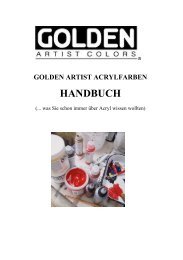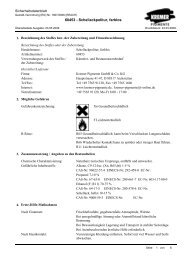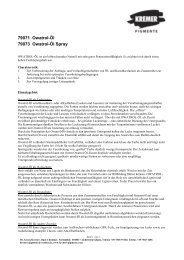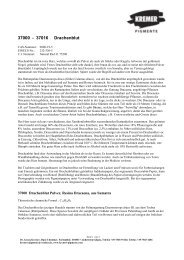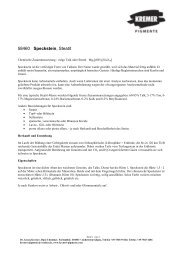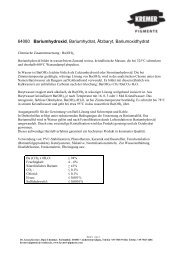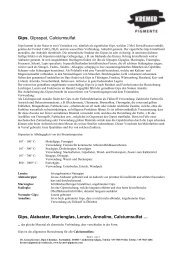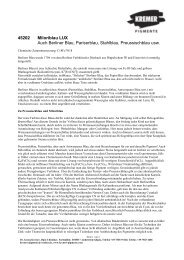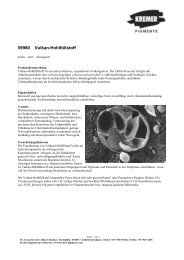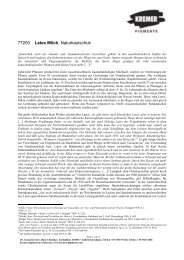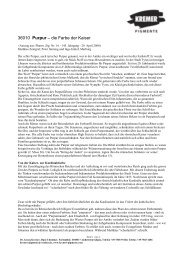70520 - Shellsol® A - Kremer Pigmente
70520 - Shellsol® A - Kremer Pigmente
70520 - Shellsol® A - Kremer Pigmente
Create successful ePaper yourself
Turn your PDF publications into a flip-book with our unique Google optimized e-Paper software.
Material Safety Data Sheet<br />
According to regulation (EC) No. 1907/2006 (REACH)<br />
<strong>70520</strong> - <strong>Shellsol®</strong> A<br />
Revised edition: 24.05.2011 Printed: 07.11.2011<br />
1. Identification of the Substance/Preparation and of the Company/Undertaking<br />
Identification of the Product<br />
Product Name: <strong>Shellsol®</strong> A<br />
Article No.: <strong>70520</strong><br />
Use of the Substance/Preparation: Artists´ and Restoration Material<br />
Relevant identified Uses of the Substance or Mixture and Uses advised against<br />
Identified uses: No information available.<br />
Company<br />
Company: <strong>Kremer</strong> <strong>Pigmente</strong> GmbH & Co. KG<br />
Address: Hauptstrasse 41-47, D 88317 Aichstetten<br />
Tel/Fax: Tel +49 7565 91120, Fax +49 7565 1606<br />
Internet: www.kremer-pigmente.de, kremer-pigmente@t-online.de<br />
Emergency No.: +49 7565 91120, Mon-Fri 8:00 - 17:00<br />
2. Hazard Identification<br />
Designation according to EC Regulation No.1272/2008<br />
GHS Classification Flammable liquids, category 3<br />
Specific Target Organ Toxicity (single exposure), category 3<br />
Aspiration hazard, category 1<br />
Chronic aquatic toxicity, category 2<br />
Hazard designation: GHS03<br />
GHS09<br />
GHS07<br />
GHS08<br />
Signal word: Danger<br />
Hazard designation: H226 Flammable liquid and vapour.<br />
H411 Toxic to aquatic life with long lasting effects.<br />
H336 May cause drowsiness or dizziness.<br />
H304 May be fatal if swallowed and enters airways.<br />
H335 May cause respiratory irritation.<br />
-- EUH066 Repeated exposure may cause skin dryness or cracking.<br />
Safety designation: P301+P310 If swallowed: Immediately call a poison center or<br />
physician.<br />
P280 Wear protective gloves/protective clothing/ eye protection/face<br />
protection.<br />
Page 1 of<br />
7
Material Safety Data Sheet<br />
According to regulation (EC) No. 1907/2006 (REACH)<br />
<strong>70520</strong> - <strong>Shellsol®</strong> A<br />
Revised edition: 24.05.2011 Printed: 07.11.2011<br />
Safety designation: P210 Keep away from heat/sparks/open flames/hot surfaces – No<br />
smoking.<br />
P273 Avoid release to the environment.<br />
P331 Do not induce vomiting.<br />
P403+P235 Store in a well ventilated place. Keep cool.<br />
P304+P340 IF inhaled: Remove victim to fresh air and keep at rest<br />
in a position comfortable for breathing.<br />
Hazardous components for<br />
Hydrocarbons, C9, aromatics<br />
labelling:<br />
Designation according to EC Regulation No. 67/548 or No.1999/45<br />
Hazard designation: N Hazardous to the environment<br />
Xn Harmful<br />
Risk Phrases: R37 Irritating to respiratory system.<br />
R67 Vapours may cause drowsiness and dizziness.<br />
R65 Harmful: May cause lung damage if swallowed.<br />
R53 May cause long-term adverse effects in the aquatic environment.<br />
R51 Toxic to aquatic organisms.<br />
R66 Repeated exposure may cause skin dryness or cracking.<br />
R10 Flammable.<br />
Safety Phrases: S23 Do not breathe gas/fumes/vapour/spray (appropriate wording to<br />
be specified by the manufacturer).<br />
S61 Avoid release to the environment. Refer to special instructions /<br />
Safety data sheets.<br />
S24 Avoid contact with skin.<br />
S62 If swallowed, do not induce vomiting: seek medical advice<br />
immediately and show this container or label.<br />
S57 Use appropriate container to avoid environmental contamination.<br />
3. Composition/Information on Ingredients<br />
Mixture :<br />
Chemical Characterization: Mixture of aromatic hydrocarbons C9-C10.<br />
Hazardous Ingredients: Hydrocarbons, C9, Aromatics (Xi,N; R10-37-65-66-67-51/53; H226-<br />
336-335-304-411) 100 %<br />
CAS-Nr: --- EINECS-Nr: 918-668-5 EC-Nr:<br />
Additional information: Benzol concentration < 0.1 weight%<br />
4. First Aid Measures<br />
Description of the First Aid Measures<br />
After inhalation: Supply fresh air. If required give artificial respiration. Keep patient<br />
warm.<br />
In case of unconsciousness place patient stable in side position for<br />
transportation.<br />
Oxygen therapy in case of impaired breathing.<br />
Page 2 of<br />
7
Material Safety Data Sheet<br />
According to regulation (EC) No. 1907/2006 (REACH)<br />
<strong>70520</strong> - <strong>Shellsol®</strong> A<br />
Revised edition: 24.05.2011 Printed: 07.11.2011<br />
After inhalation: Consult physician immediately.<br />
After skin contact: Remove contaminated clothing immediately. Wash off immediately<br />
with plenty of water and soap.<br />
If irritation continues consult a physician.<br />
After eye contact: Rinse open eye for several minutes under running water. Should<br />
irritation continue, seek medical advice.<br />
After ingestion: Rinse mouth with plenty of water.<br />
Do not induce vomiting. Consult physician immediately.<br />
Careful when vomiting. Risk of aspiration. Keep respiratory tract<br />
open.<br />
In case of spontaneous vomiting, bring unconsciousness person in a<br />
stable side position.<br />
Important Symptoms and Effects<br />
Possible symptoms: Headache, drowsiness, unconsciousness, dry skin.<br />
Information Regarding First-Aid or Special Treatment<br />
Information for physician: If vomiting occurs after ingestion, aspiration into the lungs can occur<br />
which can cause a chemical pneumonia or suffocation.<br />
5. Fire-Fighting Measures<br />
Extinguishing Media<br />
Suitable extinguishing media: Foam, carbon dioxide (CO2), extinguishing powder, water jet.<br />
Fight larger fire with water jet or alcohol resistant foam.<br />
Unsuitable extinguishing media: Water with full jet.<br />
Special Hazards<br />
Special hazards: Combustible.<br />
Fumes can form an explosive mixture with air.<br />
The vapor is heavier than air, spreads along the ground and distant<br />
ignition is possible.<br />
In case of fire: formation of carbon oxides.<br />
Fire-Fighting Measures:<br />
Protective equipment: Wear self-contained respiratory protective device and full protective<br />
gear.<br />
Further information: Cool exposed containers with water mist.<br />
Collect contaminated extinguishing water and debris separately;<br />
avoid contamination of sewage system.<br />
6. Accidental Release Measures<br />
Personal Precautions and Protective Measures<br />
Personal precautions: Wear appropriate protective equipment. Keep spectators away.<br />
Close leaks without taking any risk.<br />
Provide adequate ventilation. Keep away from sources of ignition.<br />
Environmental precautions: Prevent contamination of soils, drains and surface water.<br />
Contact local authorities if product pollutes soil or vegetation.<br />
Methods of cleaning/absorption: Contain with absorbent material (sand, diatomaceous earth, universal<br />
absorbent, Oil Dri) and dispose accordingly.<br />
Page 3 of<br />
7
Material Safety Data Sheet<br />
According to regulation (EC) No. 1907/2006 (REACH)<br />
<strong>70520</strong> - <strong>Shellsol®</strong> A<br />
Revised edition: 24.05.2011 Printed: 07.11.2011<br />
Methods of cleaning/absorption: Dispopse of contaminated material as waste according to section 13.<br />
Vapors in combination with air can form an explosive compound.<br />
Reference to other Sections: Protective clothing, see para. 8.<br />
7. Handling and Storage<br />
Handling<br />
Instructions on safe handling: The usual precautionary measures are to be adhered to when<br />
handling chemicals.<br />
Provide adequate ventilation.<br />
Avoid contact with eyes and skin.<br />
Do not breathe vapors, aerosols.<br />
Information on fire and explosion<br />
protection:<br />
Keep away from sources of ignition - do not smoke. Take measures<br />
to prevent electricity static discharge.<br />
Storage<br />
Storage conditions: Store in tightly sealed containers in a dry and cool room.<br />
Store out of direct sunlight.<br />
Product is combustible.<br />
Keep away from ignitable sources and fire.<br />
Requirements for storage areas Store in a room with a solvent-proof floor.<br />
and containers:<br />
Storage compatibility: Do not store together with: strong oxidants.<br />
Storage class (VCI): 3: Flammable liquids<br />
8. Exposure Controls/Personal Protection<br />
Technical protective measures: No further measures, see Section 7 and 8.<br />
Parameters to be controlled (DE): TRGS 900<br />
C9-C15 Aromatics<br />
Value: AGW (D): 100 mg/m3; 2(II)<br />
Personal Protective Equipment<br />
General protective measures: Keep away from foodstuffs and drinks. Do not eat, drink or smoke<br />
during work. Wash hands before breaks and at the end of work.<br />
Avoid contact with eyes and skin.<br />
Respiratory protection: Respirator mask required if ventilation is insufficient. Wear filter<br />
respirator in case of short-term or low exposure, and wear a selfcontained<br />
breathing apparatus in case of long-term or higher<br />
exposure.<br />
Hand protection: Protective gloves. The glove material has to be impermeable and<br />
resistant to the product / substance / preparation.<br />
Protective glove material: Fluoro carbon rubber, nitrile rubber.<br />
Eye protection: Tightly fitting safety goggles.<br />
Body protection: Protective clothing (flame-proof, antistatic).<br />
Environmental precautions: Avoid contamination of sewage system, open water ways and ground<br />
water.<br />
9. Physical and Chemical Properties<br />
General Information<br />
Page 4 of<br />
7
Material Safety Data Sheet<br />
According to regulation (EC) No. 1907/2006 (REACH)<br />
<strong>70520</strong> - <strong>Shellsol®</strong> A<br />
Revised edition: 24.05.2011 Printed: 07.11.2011<br />
Form: liquid<br />
Color: colorless<br />
Odor: aromatic<br />
Melting temperature: -50°C<br />
Boiling temperature: 140-200°C<br />
Flash point: > 35°C<br />
Ignition temperature: 450°C<br />
Self-ignition: Product is not auto-ignitable.<br />
Explosion risk: Product is not explosive; however, an explosive vapor/air mixture<br />
can be formed.<br />
Lower explosion limit: 0.8 Vol.%<br />
Upper explosion limit: 7.0 Vol.%<br />
Vapor pressure: 5 hPa (20°C)<br />
Density: 0.868 - 0.878 g/cm3 (15°C)<br />
Solubility in water: insoluble<br />
Viscosity dynamic: 1.0 mm2/s (20°C)<br />
10. Stability and Reactivity<br />
Reactivity: No decomposition if used according to specifications.<br />
Chemical stability: Stable if used according to specifications.<br />
Réactions dangereuses: Formation of explosive vapor-air-mixtures possible.<br />
Conditions to be avoided: Avoid contact with heat, sparks and open fire.<br />
Avoid direct sunlight.<br />
Substances to be avoided: Strong oxidizing agents.<br />
Hazardous decomposition<br />
products:<br />
Carbon oxides<br />
11. Toxicological Information<br />
Acute Toxicity<br />
LD50, oral: > 2000 mg/kg (rat)<br />
LD50, dermal: > 2000 mg/kg (rabbit)<br />
Primary effects<br />
Irritant effect on skin: Causes mild skin irritation. Prolonged contact may cause dermatitis.<br />
Irritant effect on eyes: Causes eye ailments, however does not damage the eye tissue.<br />
Iinhalation: Irritates the respiratory tract.<br />
Ingestion: Small amounts which can intrude the lungs after swallowing or by<br />
aspiration after vomiting, can cause a pulmonary edema or<br />
pneumonia.<br />
Sensitization: No sensitizing effects known.<br />
Further toxicological effects: Aspiration into the lungs when swallowed or vomited may cause<br />
chemical pneumonitis. Product is irritating, respectively, caustic for<br />
the respiratory tract.<br />
Inhalation of high vapor concentrations can be narcotic and may<br />
cause depression of the central nervous system.<br />
12. Ecological Information<br />
Page 5 of<br />
7
Material Safety Data Sheet<br />
According to regulation (EC) No. 1907/2006 (REACH)<br />
<strong>70520</strong> - <strong>Shellsol®</strong> A<br />
Revised edition: 24.05.2011 Printed: 07.11.2011<br />
Persistency and Degradability: The product floats on the water surface and does not dissolve.<br />
Readily biodegradable.<br />
The product evaporates slowly.<br />
Bioaccumulation: The main components float on the water surface and do not dissolve.<br />
Mobility: Insoluble.<br />
- Fish toxicity: LL50: 9.22 mg/l (96h, Oncorhynchus mykiss)<br />
EL50: 3.2 mg/l (48h, Ceriodaphnia Dubia (Crustacea))<br />
- Algae toxicity: EC50: 2.6-2.9 mg/l (72h; Pseudokirchneriella subcapitata)<br />
Results of PBT vPvB assessment: This product is neither a PBT or vPvB substance nor does it contain<br />
a PBT or vPvB substance.<br />
Further information<br />
Water hazard class: 2<br />
Do not let product contaminate ground water, waterways or sewage<br />
system.<br />
Danger to drinking water even if small quantities leak into the<br />
ground. Also poisonous for fish and plankton in water bodies.<br />
13. Disposal Considerations<br />
Methods<br />
Product: Must not be disposed together with household garbage.<br />
Do not let product enter water systems.<br />
Dispose of according to official national and local regulations.<br />
Uncleaned packaging: Dispose of according to official local regulations.<br />
Uncontaminated packaging may be recycled. Completely empty<br />
packaging can be disposed of with the regular waste.<br />
Do not puncture, cut or weld uncleaned drums.<br />
14. Transport Information<br />
Road Transportation ADR/RID<br />
Class: 3<br />
Packaging group: III<br />
UN No.: 3295<br />
Classification code: F1<br />
Tunnel No.: D/E<br />
Hazard No.: 3<br />
Correct technical name: HYDROCARBONS, LIQUID, N.O.S. (Solvent naphtha (petroleum),<br />
light aromatic)<br />
Sea transportation<br />
IMDG/GGVSee Class: 3<br />
Packaging group: III<br />
UN No.: 3295<br />
EmS No.: F-E,S-D<br />
Hazard No.: 3<br />
Marine pollutant: P<br />
Page 6 of<br />
7
Material Safety Data Sheet<br />
According to regulation (EC) No. 1907/2006 (REACH)<br />
<strong>70520</strong> - <strong>Shellsol®</strong> A<br />
Revised edition: 24.05.2011 Printed: 07.11.2011<br />
Correct technical name: HYDROCARBONS, LIQUID, N.O.S. (Solvent naphtha (petroleum),<br />
light aromatic)<br />
Air transportation<br />
ICAO/IATA Class: 3<br />
Packaging group: III<br />
UN No.: 3295<br />
Hazard No.: 3<br />
Correct technical name: HYDROCARBONS, LIQUID, N.O.S. (Solvent naphtha (petroleum),<br />
light aromatic)<br />
15. Regulatory Information<br />
National Regulations (D)<br />
Local regulations on chemical Underlies the Accident Ordinance 13<br />
accidents:<br />
Employment restrictions: The employment restrictions for young workers in accordance with<br />
the Youth Employment Protection Law (94/33/EC) are to be<br />
observed.<br />
The employment restrictions for expectant and nursing mothers in<br />
accordance with the Maternity Protection Guideline (94/85/EEC) are<br />
to be observed.<br />
Water hazard class: 2, hazardous for water<br />
Chemical safety assessment<br />
Chemical safety assessment: No information available.<br />
16. Other Information<br />
This product should be stored, handled and used in accordance with good hygiene practices and in<br />
conformity with any legal regulations.<br />
This information contained herein is based on the present state of knowledge and is intended to describe<br />
our product from the point of view of safety requirements. It should be therefore not be construed as<br />
guaranteeing specific properties.<br />
Page 7 of<br />
7


